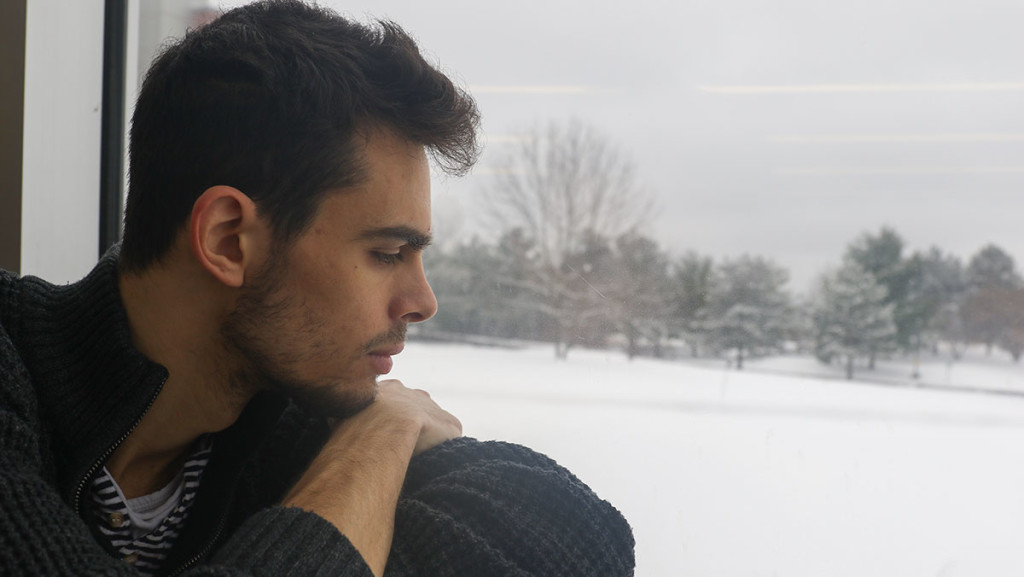It’s no secret that Ithaca is known for its brutal winter weather. Constant wind, chilly temperatures, the presence of snowfall and dark gray clouds blanketing the sky can make many students feel forlorn and down. But while the dreariness can cause a drop in mood for a day, this winter weather can have an adverse impact on other students, affecting their mood and emotional state over the course of a few months.
This rings true for Ithaca College senior Nicolas Rocco, who lives with seasonal affective disorder, more commonly known as seasonal depression — a mood disorder and form of depression that is concomitant with the changing of the seasons and is mostly prevalent during the fall or winter months. According to research conducted by psychiatrist Norman Rosenthal, the first doctor to describe the SAD description, seasonal depression mostly occurs during the fall and winter seasons because of the lack of sunlight. Research done by the American Psychiatric Association has linked SAD to a biochemical imbalance in the brain as a result of shorter daylight hours and a lack of sunlight intake. However, this has not been proven as the sole conclusive cause of seasonal depression. Having seasonal depression generally causes fluctuations in mood, energy level and concentration.
Seasonal depression, Rocco said, is something that runs in his family; his mother has been living with it for many years. Rocco said he feels the grogginess and fatigue that is commonly associated with seasonal depression, and said a combination of SAD and the Lyme disease he suffered in the last few years has made it more difficult to get through the months.
“I would describe it as a constant struggle to get out of bed, you know, to really find within yourself a catalyst to get moving,” he said. “You just feel very groggy. You feel very tired.”
Rocco’s mother, Maria, said she began noticing her own symptoms of seasonal depression 20 years ago. She said that while living with SAD in the winter makes her feel unhappy and unmotivated, it does not completely stop her from doing what she needs to do but only makes it more difficult.
“It’s just harder to get up and do what I need to do,” she said.
Born in Brooklyn and then moving to Rockland County, New York, Rocco said he never became acutely aware of his SAD until he came to Ithaca, where the winter weather worsens his seasonal depression. Upon starting at the college, Rocco said he noticed himself struggling and lacking the motivation to interact with others during the winter months.
“I’ve never really had problems talking to people. I’m a very approachable person,” he said. “I like being very open with people. My life is basically an open book, but when the seasons would roll in, when it would be gray and dreary and snowy, I would find myself in a place where I would not want to interact with other people. And I wouldn’t know why, but I’d just be like, ‘I don’t want to speak to people,’ and I’d make all these excuses. It’d really only happen within that six-month frame, and then as soon as summer hit, I’d be twirling and dancing outside.”
Upon transferring to the college, Rocco said the seasonal depression has come to take a toll on him after three years in Ithaca. He said switches in the weather from warm and sunny to cold and dreary mirrors the transitions in mood he experiences.
“I’ll be in a certain mindset in a certain mood, and then like the snap of fingers I’ll go into a classroom and then come back out, and it’ll be a completely different environment that I’m facing,” he said. “It’s almost like a puppeteer, I guess, toying with the emotions or like some sort of marionette doll.”
Not only can dreary winter weather impact seasonal affective disorder, but constant weather fluctuations can also add to the depressive experience of living with the disorder.
Data from Cornell University’s Northeast Regional Climate Center from December 2015 to February 2016 shows this winter season as being warmer than normal and having below–normal snowfall levels. However, NRCC climatologist Samantha Borisoff said while December was consistent in having temperatures that were above normal, there were many periods in January and February when temperatures would move from above normal to below normal, resulting in a variation in the weather during these two months.
Having a mild winter is generally unseasonal when compared to winters from 2014–15 and 2013–14, as data from the NRCC shows temperatures that are most consistently below normal. Borisoff said the 2014–15 winter began warmer than normal but was followed by chillier temperatures from January to February. This pattern, she said, is more consistent in temperature to the 2013–14 winter, which showed cooler temperatures and normal snowfall during that three-month period. She said this year’s winter season does not follow this pattern of consistency.
“We’ve seen kind of a flip–flop from where we were two years ago to where we are now,” she said.
For Rocco, the differences between this winter and those of past years — and the lack of consistency in the weather — has notably impacted living with seasonal depression even more negatively.
“I feel that last year, there was a consistency to the weather, whereas here, we’re going to throw at you a few negative sevens, and we’re going to do that back to back a few days, maybe even a week or two,” he said. “It’s definitely been much more of a struggle for me personally because I can’t seem to settle on something.”
One of the primary methods of treatment for SAD is light therapy, in which light boxes are used to emit high levels of light that imitate natural sunlight and help improve one’s mood by limiting the secretion of melatonin in the brain, a sleep hormone that is linked to depression. At the college, students can find a Sunbox Light Therapy Unit at the resource room in the Center for Health Promotion.
Rocco copes with seasonal depression by spending time with friends and listening to music as a form of therapy.
“Friends help a lot with coping,” he said. “I find that being with people and definitely vibing off their mood, especially if we’re having a good time — if we’re laughing, if we’re joking, even if we’re doing some stupid charade — it definitely does lighten the entire environments around me.”
On the other hand, Maria said either going out or relaxing are her ways of dealing with seasonal depression.
“I just have to push myself to get up and get out as much as I can, just stay active,” she said. “I exercise, I go to the gym, and there’s some days that I just let myself hang out on the couch and watch movies.”
Although she currently lives in Rockland County, Maria said she’s begun thinking about moving someplace warmer and sunnier. And as Ithaca begins to ease into the spring season, Rocco said his seasonal depression is gradually getting better, as is the case for most who live with SAD during the winter months.
“It’s like a steady climb. It’s like a very long staircase,” he said. “And as each season and each week slowly passes, I do feel as if … I am ascending a bit higher.”














